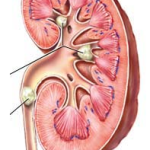What is Urinary Stone Disease?
Urinary stone disease is an ancient and common affliction of man. Over a 70 year life span, it is estimated that upto 15% of people will develop renal stones. Although very few individuals die as a direct result of stone disease, it does lead to significant suffering from pain, urinary infections, and obstructive damage to the kidneys. Though newer and more effective methods of stone treatment are available, the actual cause of stone formation frequently remains unknown. So recurrence is bound to occur.
Urinary stones occur in all parts of the urinary system. 97% of all urinary stones are located in the kidney and ureter. Only 3% are found in the bladder and urethra.
How a stone is formed?
Urine contains many dissolved substances and when they become concentrated they form crystals. These crystals grow and join together to form a stone. The formation of urinary stones has a multi-factorial origin. Socio-economic, genetic, constitutional factors, as well as diet, drugs, anatomic, functional and metabolic abnormalities, all play a part. One of the main reason stones form, is the loss of body fluids or being dehydrated. A deficiency of some substances which inhibit the growth and aggregation of crystals in urine will also permit stone formation. A less common cause of stone formation is secondary to infection in the urinary tract (struvite stone). This type of stone can grow rapidly and can fill the entire kidney.
What is the composition of these stones?
Urinary stones are actually biominerals. They contain both inorganic and organic substances. There are different types of stones. Calcium oxalate is by far the most common stone constituent, and is seen in at least 80% of all the stones. Other common stones are calcium phosphate, uric acid, struvite, cystine, etc. If you have passed out a stone, you can get the stone analyzed.
What are the symptoms of a urinary tract stone?
- Mild/moderate or severe pain
- Passage of blood in the urine
- Passage of stone in the urine
- Urinary tract infection
- Burning sensation when urinating
- Urinary block
- No symptoms at all
How are urinary tract stones diagnosed?
To evaluate the presence of stones, preliminary urine analysis followed by an ultrasonography will give most of the information. To study the actual kidney function, an Intravenous urogram (x-ray) needs to be performed. In case of further doubts, additional tests like isotope renogram,cystoscopy and retrograde studies of the urinary tract, and CT scan of the urinary tract may be performed.
How are urinary tract stones treated?
Initial treatment will focus on relief of pain. After this, the next step will be to facilitate either passage or removal of the stone itself. 80-90% of all stones less than 5 mm will pass out on their own. If the stone is smooth, even stones of 7- 8 mm may pass out on their own. A combination of drugs called the medical expulsive therapy promotes stone expulsion with far less pain. This is the first line of therapy now. Stones larger than this will invariably need to be removed by one of the many methods available. If there is an anatomical abnormality, the priority will be to correct that abnormality while removing the stone. 1-2 cm solitary stones in the kidney can be treated preferably by ESWL (Extracorporeal Shock Wave Lithotripsy). This is the method by which pressure waves from the machine are focussed on to the stone and the stone is powdered. The stone fragments will pass out in the urine over a period of 1 to 12 weeks. Larger stones in the kidney are preferably removed by PCNL (Percutaneous Nephrolithotomy). In this method the patient needs to be admitted, a small puncture is made from the back directly into the kidney; the stone is visualized, fragmented and removed completely.
Stones lower down in the urinary tract may be treated either by ESWL or by endoscopic methods. In this, an endoscope is passed into the urinary tract from external meatus, the stone visualized, and fragmented.
Open surgery for stones in the ureter is used only in complicated cases.
Uric acid stones are generally seen only on the ultrasound, and not on x-rays film. If they are around 1 cm in size, they can be the dissolved by simple alkalinisation of the urine.
How can urinary tract stones be prevented?
Most patients with urinary stones need to make certain minimal changes in their diet that may help in prevention of a recurrence. These include
- High intake of neutral fluids like water, tender coconut water, dilute buttermilk, citrus juices etc., unless contraindicated for some other reason. They should limit the amount of coffee, tea or milk taken to 1-2 cups a day. The total oral fluid intake should be such that urine output is at least 1.5 to 2 liters/day.
- Food must preferably be vegetarian, and high in fiber. For a general balanced Indian diet, no particular vegetable needs to be avoided.
- Meat eaters should confine the amount of meat in their diet. The total intake is restricted to around 50-75 gm/day. A dietician’s help can be taken to calculate this.
- Carbonated soft drinks containing high amount of sugar, and calorie rich food like – sweets, milk sweets etc., should be avoided,especially on an empty stomach.
Separate and specific changes in the diet may be suggested in case of other conditions associated with urinary stones.
Patients suspected of having other metabolic or endocrine problems will need to undergo detailed testing. These are generally reserved for those patients having recurrent/ bilateral stones / family history of stone formation in children. These tests would include fasting, blood tests and 24 hour collection of urine for 3 days.

